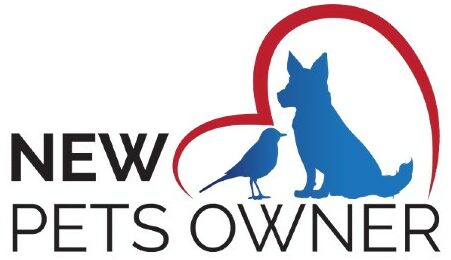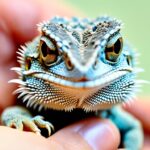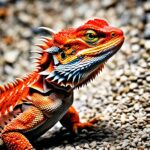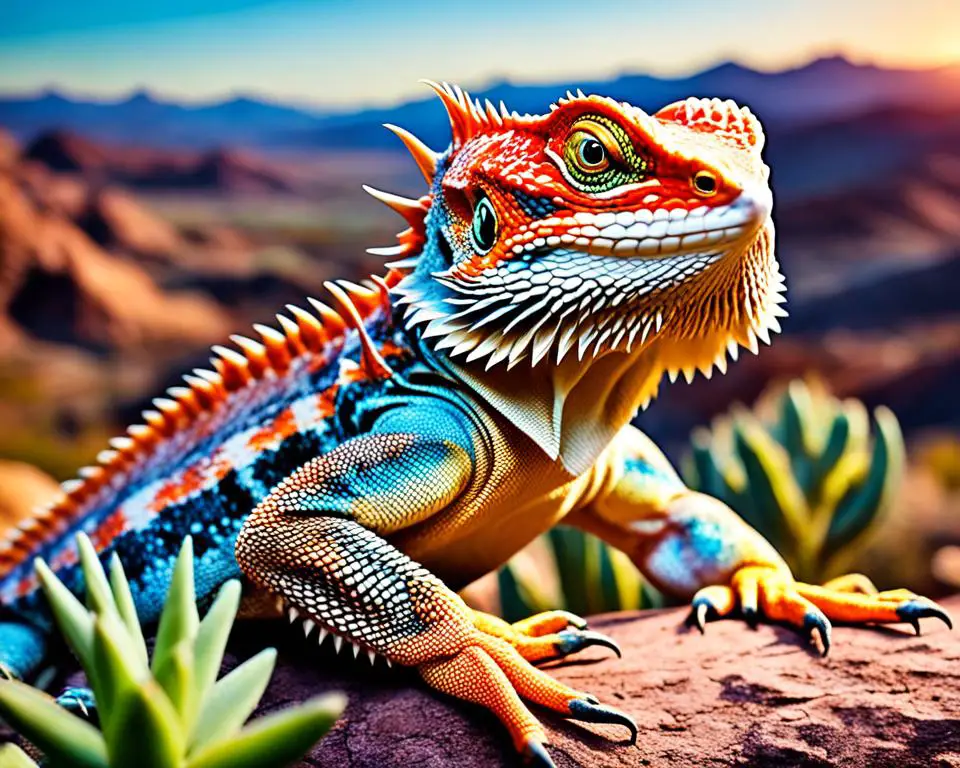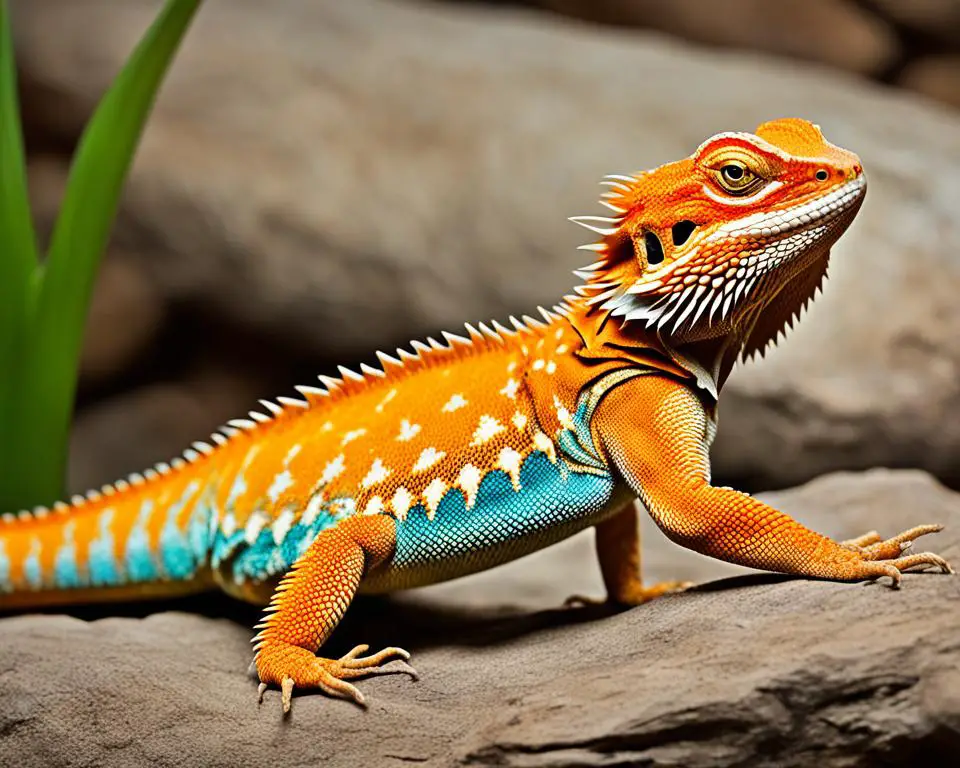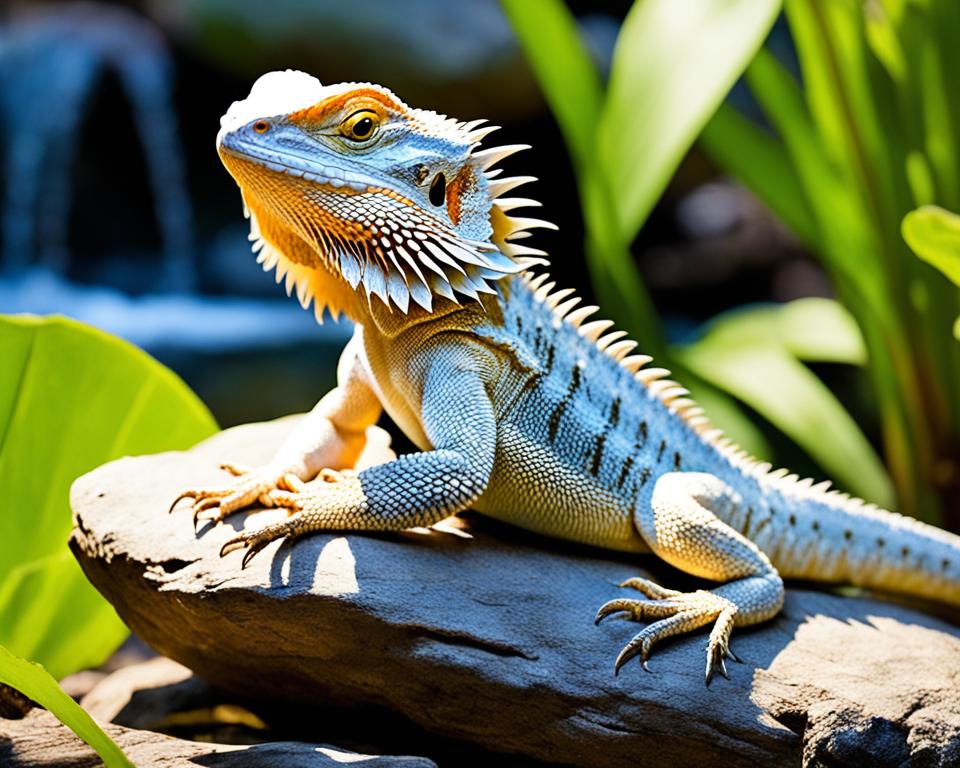Bearded dragons, also called “beardies,” are getting more popular as pets in the U.S. They come from Australia and are part of the Pogona genus, especially the Pogona vitticeps species. The blue bearded dragon is known for its special color.
These lizards have a “beard” of spiky scales that can puff out when they’re excited or stressed. They are active during the day. So, they need a special light cycle in their home.
They need 12 hours of daylight with UVB lighting for their health and warmth. Then, they need 12 hours of darkness at night. This helps them stay healthy.
Bearded dragons eat both plants and insects. Brown crickets are a main food, and mealworms can be a treat. They also need veggies like kale, peppers, and carrots for nutrition.
These *exotic pets* need a big tank to grow. It’s best to keep only one bearded dragon in a tank to prevent fighting. Taking them to the vet regularly is important to keep them healthy. They can live up to 10-15 years in captivity.
Knowing what they need helps keep your bearded dragon happy and healthy. We’ll go into more detail about their care and the best way to set up their home.
Introduction to Bearded Dragon Blue
Bearded dragons come from Australia’s diverse lands. They are known as Pogona vitticeps. These reptiles live in many places, from deserts to grasslands. They can handle hot days and cool nights.
The central bearded dragon, or Pogona vitticeps, is a favorite pet. This is because they are easy to care for and look beautiful.
Background and Origin
Bearded dragons have a long history in Australia. They lived in semi-arid areas, woodlands, and grasslands. This shows how adaptable they are.
Over time, people have bred them to have different colors. In the U.S., these dragons are bred to be healthier and better suited for pets. Knowing where they come from helps take good care of them.
Why Choose a Bearded Dragon Blue?
The Bearded Dragon Blue is a special choice. They have bright and striking colors, including vivid blues. These colors are less common than brown and tan.
Red and yellow dragons are more common, but orange and white are rare. There are also different scales like leatherback and silkback. Patterns like Blue Bars make them stand out.
These dragons are friendly and not too big. They are great pets for anyone who likes reptiles. Their origins make them tough and easy to care for.
Setting Up the Perfect Habitat
Creating the perfect bearded dragon habitat setup is key for your pet’s health and happiness. A well-designed reptile enclosure that mirrors their natural home is vital. It helps keep your bearded dragon healthy and full of life.
Key parts of a bearded dragon’s home include big tanks, safe ground cover, and the right heat and light. Adults need tanks that are at least 50 to 125 gallons big, with a size of 120 x 60 x 60 cm (4 x 2 x 2 ft). You can choose from glass terrariums, wood and glass ones, or PVC enclosures. But, avoid terrariums with screens as they can be dangerous.
It’s important to pick a good spot for the tank. Make sure it’s not in direct sunlight, has enough room, and is safe from pets and kids. Bearded dragons don’t get along well with each other, so keeping them apart is best.
When choosing a ground cover, stay away from reptile carpet as it can hurt your pet and cause health problems. Instead, use sandy desert ground cover to make it feel like home. But, be careful not to use too much to prevent blockages.
Adding things like climbing perches, hiding spots, and plants helps your bearded dragon feel less stressed and bored. This makes for a better bearded dragon environment. Don’t forget to change the UVB lights every six months to keep the light and heat right.
For heating, use heat lamps or ceramic heaters to create a warm and cool area in the tank. The temperature should go from 40°C (104°F) at the warm end to 25°C (77°F) at the cool end. This keeps your bearded dragon happy and active.
Choosing the Right Terrarium for Your Bearded Dragon Blue
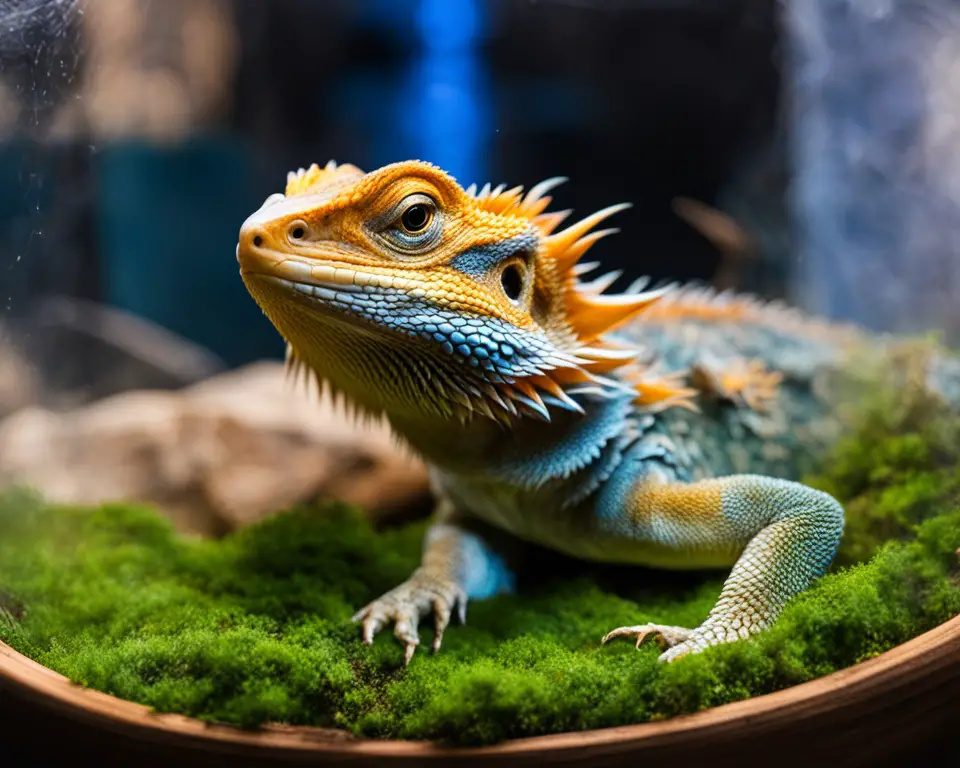
Choosing the right terrarium for bearded dragons is key to their health and happiness. An adult bearded dragon needs a space of at least 6’L x 2’W x 2’H (1.8m x 0.6 x 0.6m). This size is perfect for exercise and keeping them mentally and physically healthy.
Blue, now in a 40-gallon ZooMed terrarium and 9 inches old, needs a bigger home. Options like the 4’x2’x2′ from Custom Reptile Habitats or the 5’x2’x2′ from Dubia are great. They offer enough space for Blue to grow and stay active. Here’s a table comparing these options:
| Brand | Enclosure Size | Pros | Cons |
|---|---|---|---|
| Custom Reptile Habitats | 4’x2’x2′ |
|
|
| Dubia | 5’x2’x2′ |
|
|
| Kages | 4’x2’x2′ |
|
|
| Cornell’s World | 4’x2’x2′ |
|
|
A terrarium for bearded dragons should have a secure screen top for air flow and UV light. They love to climb, so the enclosure should be at least 3 feet tall. The tank must be strong to hold basking rocks and branches.
It’s also important to have a temperature gradient and UV lighting for your bearded dragon’s health. Brands like Dubia and Custom Reptile Habitats are trusted for their quality. They provide a safe space for Blue to grow and stay healthy.
Essential Heating and Lighting Requirements
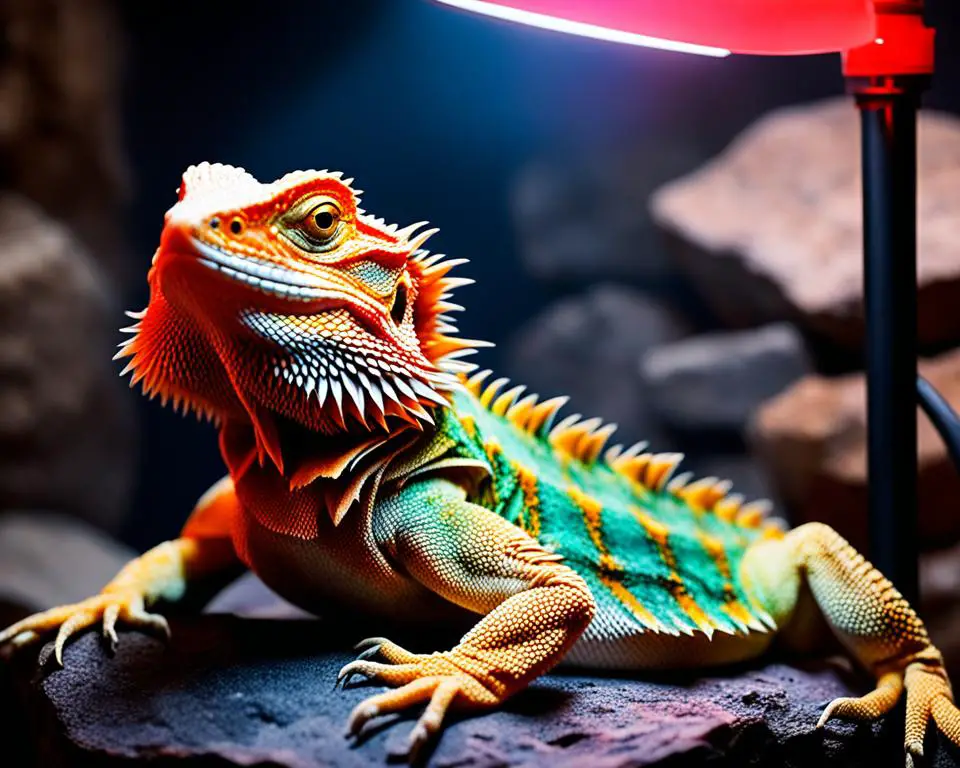
Creating the perfect home for your bearded dragon means knowing their heating and lighting needs. These creatures love bright light during the day. It’s important to set up the right temperature in their terrarium.
For the right bearded dragon heating, your terrarium needs a hot spot of 105-115°F (40-46°C) and a cooler area of 70-85°F (21-29°C). This lets your bearded dragon control its body temperature.
You can use different bulbs for heating:
- Incandescent bulbs: Give off light and heat, like sunlight.
- PAR38 Halogen bulbs: Great for their efficiency and heat.
- Ceramic Heat Emitters (CHE) and Deep Heat Projectors (DHP): Perfect for focused heat.
A drop in temperature at night is good, aiming for 65-70°F (18-21°C). Use precise thermometers to keep your pet’s space stable.
UVB lighting is key for your bearded dragon’s health. It helps make vitamin D3, important for bone health and overall health. A 22” Arcadia Dragon 14% bulb is good for a 48″ x 24″ x 24″ terrarium, giving enough UV. Turn the light on for 14 hours in summer and 10 hours in winter to match daylight.
Reptile basking bulbs should have a color temperature of 6000-7000K, like natural sunlight. This helps your dragon act naturally and stay mentally healthy.
| Heating Element | Purpose | Recommendation |
|---|---|---|
| Incandescent Bulbs | Provide ambient light and heat | Daytime use |
| Pocket Halogen Bulbs | Energy-efficient basking spots | Fluctuating light cycles |
| Ceramic Heat Emitters (CHE) | Generate steady, non-light heat | Suitable for night-time |
Remember, your bearded dragon relies on you for these perfect conditions. Good heating and UVB lighting setups are crucial for their health and happiness.
Maintaining Optimal Humidity and Temperature

Keeping the right humidity and temperature in your Bearded Dragon Blue’s home is key to its health. These reptiles do best in environments that mimic their natural habitats. The right humidity and temperature can make their lives better and longer.
Humidity Levels
Bearded dragons need humidity levels of 35% to 40%. Too much can cause breathing problems, while too little can lead to dehydration and shedding issues. It’s important to use a precise hygrometer to check the humidity. You can also mist the enclosure or add a water dish to keep the humidity right.
Temperature Ranges
Bearded dragons need a warm spot to bask during the day, with temperatures between 108-113°F (42-45°C). A strong halogen bulb under a dome heat lamp works well for this. At night, the temperature can drop to 50°F if the day is warm enough.
Using different types of heaters, like Radiant Heat Panels and Ceramic Heat Emitters, helps create a good temperature range. This setup keeps your bearded dragon comfortable and lowers the chance of getting sick from temperature issues.
Here’s a table with the main temperature needs for different reptiles:
| Species | Daytime Temperature Range (°F) | Nighttime Temperature Range (°F) | Humidity Levels (%) |
|---|---|---|---|
| Bearded Dragon | 108-113°F | 50°F | 35-40% |
| Desert Iguana | 90-110°F | 65-85°F | 10-30% |
| Boa Constrictor | 85-95°F | 70-85°F | 50-80% |
| Crested Gecko | 75-80°F | 75°F | 70-80% |
Getting the right balance in temperature and humidity is key for your pet’s health.
Feeding Your Bearded Dragon Blue a Balanced Diet
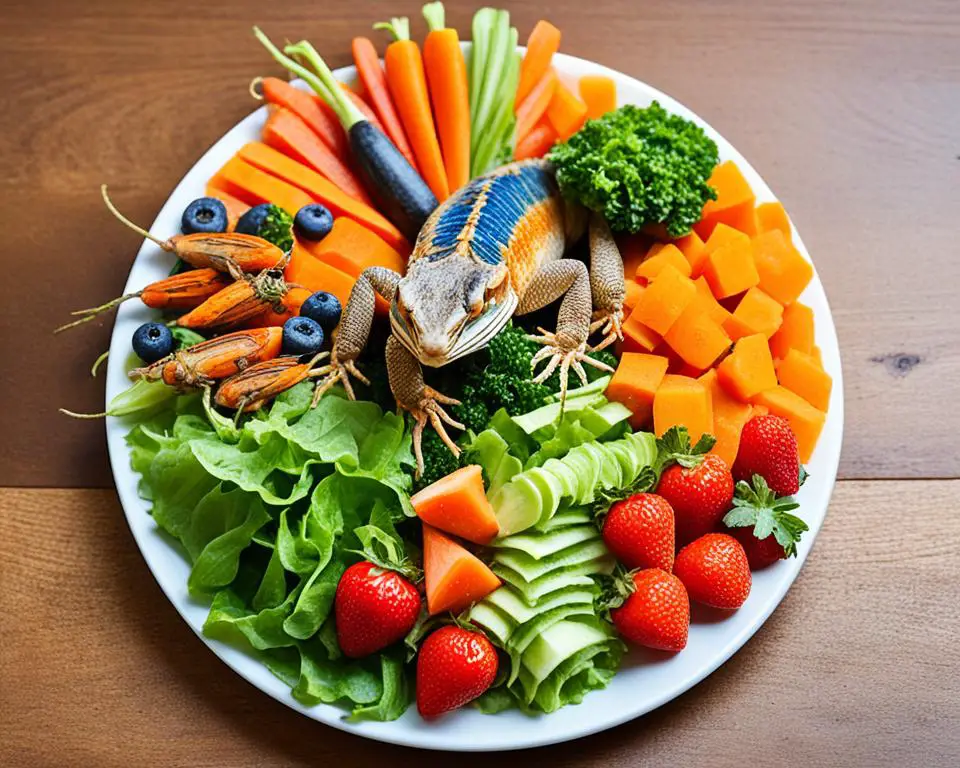
Feeding your bearded dragon the right foods is crucial for its health and long life. Their diet should include insects, vegetables, and sometimes fruits. Let’s look at what your bearded dragon blue needs to eat to stay healthy at home.
Insect and Vegetable Balance
Bearded dragons need a diet that matches their natural eating habits. Young dragons eat more insects, while adults eat more plants. Here’s a simple guide:
| Age Group | Insect Percentage | Plant Percentage |
|---|---|---|
| Hatchlings | 60-80% | 20-40% |
| Juveniles | 50-80% | 20-50% |
| Adults | 20-30% | 70-80% |
Good insects for bearded dragons are crickets, dubia roaches, and worms like mealworms and silkworms. For plants, collard greens, kale, and dandelion leaves are good choices. But, avoid avocado and mushrooms as they are bad for them. Fruits like apples, blueberries, and mangoes should be 10-20% of their diet.
Recommended Supplements
Calcium and multivitamin supplements are key for your bearded dragon’s diet. Dusting their food with calcium and vitamin D3 helps keep their bones strong and prevents diseases. Also, a balanced calcium-to-phosphorus ratio is important for their health.
For feeding bearded dragons, hatchlings eat insects twice a day and veggies every day. Juveniles get insects once a day with veggies. Adults eat insects 2-3 times a week and veggies daily. Always give them fresh, clean water, mostly from fresh produce, and watch how much they drink to keep them hydrated.
If your bearded dragon is picky, try different feeding methods like hand-feeding or foraging tricks. Keeping their diet varied is key to meeting their needs and avoiding boredom.
Understanding Behavioral Patterns and Socialization

Understanding bearded dragon behavior can make the bond between pet and owner stronger. Bearded dragons are social and use bearded dragon body language to communicate. They show dominance or submission through head bobbing, arm waving, and beard puffing.
Bearded dragons are friendly and love to interact with their owners. They get along well with handling and may even sit on shoulders. This makes them popular among reptile lovers.
Positive reinforcement is key to good reptile socialization. Use treats or kind words to encourage good behavior. This makes your pet’s time with you positive.
The right environment is important for bearded dragon behavior and socialization. A safe habitat helps your bearded dragon feel secure. This affects how they act around you and others.
Unlike some reptiles, bearded dragons are easy to care for and great for beginners. They are social, making them perfect for families or individuals. They form strong bonds with their owners.
Common Health Issues and Preventative Care
Bearded dragons are tough pets but can face health problems like metabolic bone disease, respiratory infections, and digestive impactions. Keeping their diet right and their living space suitable is key to keeping them healthy.
Feeding them the right foods is vital to avoid bone diseases. Young dragons need calcium and Vitamin D3 in their diet. They also need UV-B light for 12 hours a day to stay healthy and prevent bone disease. Remember to change UV-B bulbs every 6-12 months.
Wrong humidity and temperatures can cause respiratory infections. These can be spotted with X-rays, blood tests, and discharge cultures. Keep their daytime area between 76°F and 86°F, and the basking spot at 95°F to 100°F. At night, keep it between 70°F and 75°F everywhere, and 80°F in the basking area.
Preventative reptile care means regular vet visits to catch diseases early. Watch for signs like eating less, being tired, swollen bellies, and limping. Be careful if you see jaw or hind limb swelling, or if they stop eating.
Keeping things clean helps prevent infections. Clean their water bowls with bleach weekly to keep water fresh. Use an infrared thermometer to check the habitat’s temperature accurately.
The following table shows common health issues, symptoms, and how to prevent them in bearded dragons:
| Health Issue | Symptoms | Preventative Measures |
|---|---|---|
| Metabolic Bone Disease (MBD) | Jaw or hind limb swelling, lethargy | Balanced diet, enough UV-B exposure |
| Respiratory Infections | Difficulty breathing, nasal discharge | Proper temperature and humidity, regular vet check-ups |
| Digestive Impactions | Constipation, swollen belly | Suitable diet, adequate hydration |
| Infectious Stomatitis (Mouth Rot) | Swollen gums, excess salivation | Proper hygiene, prompt vet consultation |
Being proactive with reptile care is key. This means feeding them right, keeping their home perfect, and seeing the vet regularly. Knowing the early signs and acting fast is key to keeping your bearded dragon healthy and happy.
Conclusion
Starting your journey with a bearded dragon is both rewarding and insightful. This guide has shown the importance of knowing their needs, from their living space to what they eat. Feeding them a mix of greens, veggies, and insects is key to their health and long life.
A study from April 3 to June 3, 2014, looked at 11 adult male Pogona vitticeps. It found out if bearded dragons have a natural color cycle. The NCBI article showed that some dragons change color in the dark, showing their colors most at night.
Looking after a healthy bearded dragon means watching their behavior and how they interact with others. Knowing how they act and breed helps you take better care of them. With the right food, environment, and health care, your bearded dragon will be happy and colorful for many years. For more on their beautiful colors, check out Talis US.
If you’re new or experienced with bearded dragons, caring for them deeply connects you with these amazing reptiles. Following the right care tips and understanding their needs makes for a fulfilling reptile ownership. For more on bearded dragon genetics and their daily cycles, see Murray State’s research.
Source Links
- How to Keep Your Bearded Dragon a Happy Reptile | Blue Lake Animal Hospital | Pet Reptile Doctor Near Grand Rapids
- Bearded Dragon Care Guide – Tips, Supplies, and FAQs | PetSmart
- How to Care for Your Bearded Dragon
- COLORS & MORPHS
- Bearded Dragon Morphs, Colors & Patterns
- different colors | General Discussion
- Bearded Dragon Tank Setup 101: How to Create the Best Home for Your Ne
- Creating the ideal Bearded dragon setup
- Bearded Dragon Bioactive care and maintenance
- Bearded Dragon Enclosure Size & Cohabitation
- What set up do I need for my Bearded Dragon? – ExoticDirect
- Reddit – Dive into anything
- Bearded Dragon Complete Lighting and Heating Guide
- The Ultimate Guide to Heating and Lighting
- Reptile & Rescue – Heating and Lighting Guide
- Bearded Dragon Lighting, Heating & Humidity Requirements
- Temperature and Humidity Monitoring for Pet Reptiles and Amphibians — SensorPush
- A complete guide to Bearded dragon temperature and heating
- The Complete Bearded Dragon Diet Plan. Keep Your Pet Healthy and Happy
- Bearded Dragon Nutrition | Arizona Exotics
- Bearded Dragon Complete Food Guide
- Exploring the Untapped Potential: Decoding the Social World of Reptiles – reptilfe
- From Terrarium To Companionship: Why Pet Lizards Make Great Pets – Kate’s K9 Pet Care
- Reptile Discovery Center
- What to Know About Bearded Dragons
- Basic Care: Bearded Dragon | Arizona Exotics
- Bearded Dragons – Diseases | VCA Animal Hospitals
- Cyclic Colour Change in the Bearded Dragon Pogona vitticeps under Different Photoperiods
- Intelligence of Bearded Dragons
- Exploring the Stunning Colors of Bearded Dragons
